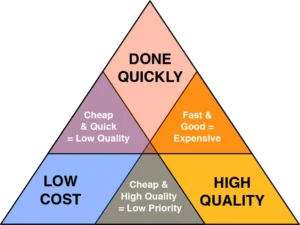A Common Form of Change
 Most business and governmental changes are difficult because several different stakeholder groups have differing interests. I call these types of changes “Provocative Changes” because they cost time, effort, and money that could be used for something else. A similar expression is “disruptive change.”
Most business and governmental changes are difficult because several different stakeholder groups have differing interests. I call these types of changes “Provocative Changes” because they cost time, effort, and money that could be used for something else. A similar expression is “disruptive change.”
Explanation & Examples
There are four major categories of Change. I describe all types on the “About Change” web page. Here, I describe Provocative Change because it is the most common type of Change in most situations.
In government, most large projects fall into this category. A good example is in street repair and maintenance. Only rarely can all streets be repaired within a short period. So, decisions must be made based on criteria that citizens might disagree with. For example:
- Should main roads be repaired before side roads?
- Should bad roads be improved if they are rarely used?
- Should a hospital road be repaired before a business road?
- Should a road be repaired in the summer or Fall?
- Should a repair crew be city employees or contracted out?
- Should a road be resurfaced only or completely replaced?
- How do you decide when fresh lines should be painted be put on roads?
- When a repair is being done, where should the detour be made?
- Are drainage and ditches as important as the road surface?
- Should a road be widened at a high cost or remain the same?
Decisions like these also require consideration of the “Value Triple Constraint.” Well-run projects use sound project management methods.
A simple way of thinking about the triple constraint is time, cost, and quality. When I was running projects, I would help clients prioritize the two most important (pick two). The third constraint would have to “give.”
-

https://medium.com/@vivekmadurai/quality-time-and-money-39278f990092 A project can have high quality and happen fast, but it will cost more
- A project can have high quality and low cost, but it will take longer
- A project can have low cost and happen fast, but it will be of lower quality
While this way of thinking through the triple constraint is not necessarily always true, it is usually true. In government, because there is a budget, either time or quality will need to be sacrificed a little bit. Some people would be okay with fast at a lesser quality. Others might be less concerned about speed as long as the end result is high quality.
The “four Ds” represent a typical sequence of project phases. Some projects get stuck in one of the first three phases and fail to deliver on the promise. Other projects need to pay more attention to the first phases and then make many mistakes when doing the work.
Define > Design > Develop > Deliver
Provocative Change typically has “winners” and “losers,” but even if everyone wins, some win more than others. It requires great communication and dealing with conflicting interests. It also requires a great deal of discipline, which professional project managers understand well.
 When vendors are chosen to lead a project or do most of the work, the procurement processes must be done well. Municipalities and small governments risk falling into “good old boy” malfeasance. Professional, unbiased procurement practices and strong project management discipline mitigate these risks.
When vendors are chosen to lead a project or do most of the work, the procurement processes must be done well. Municipalities and small governments risk falling into “good old boy” malfeasance. Professional, unbiased procurement practices and strong project management discipline mitigate these risks.
Choosing Among Valid Options
Most government decisions are not deviant–rather they are simply difficult choices that don’t please everyone. These decisions can be internal or external.
Internal (organizational) examples
- On-going process improvements
- Putting accounting controls in place
- New employee evaluation methods
- Installing new technology
- Succession planning
- Most Human Resources actions
- Deciding which equipment to purchase
- Relocating departments
- Changes in work area arrangements
- Constructing community facilities
External Examples
 Allowing a foreign-owned corporation to operate in the city
Allowing a foreign-owned corporation to operate in the city- Municipal purchase from a local vendor versus other choices
- Contracting services to a firm (or outsourcing work)
- Building a park rather than repairing roads
- Hosting a motorcycle rally that temporarily blocks roads
Related pages: About Change; Our City.